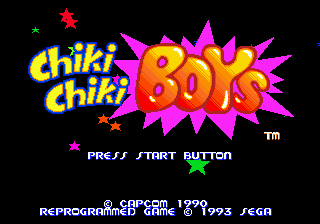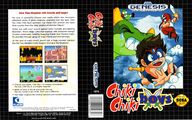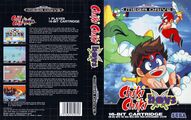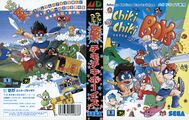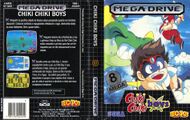Difference between revisions of "Chiki Chiki Boys"
From Sega Retro
m (Text replacement - " {{fileref|" to "{{fileref|") |
|||
| Line 1: | Line 1: | ||
| − | |||
{{Bob | {{Bob | ||
| bobscreen=Chikichiki title.png | | bobscreen=Chikichiki title.png | ||
| Line 27: | Line 26: | ||
}} | }} | ||
}} | }} | ||
| − | '''''Chiki Chiki Boys''''' (チキチキボーイズ), also known as '''''Mega Twins''''' in some areas, is an arcade game by Capcom first released in 1990 and ported to the [[Sega Mega Drive]] in 1992 by [[Sega]] and [[Visco]]. The game features two twins who are attempting to re-take control of their land, Alurea, after a monster unexpectedly attacks, destroying everything in its path. The people of Alurea have lived in peace for a thousand years and have forgotten how to fight, yet the land's only survivors, the twin sons of the king, must take up the challenge and return their kingdom to its former glory. | + | '''''Chiki Chiki Boys''''' (チキチキボーイズ), also known as '''''Mega Twins''''' in some areas, is an arcade game by [[Capcom]] first released in 1990 and ported to the [[Sega Mega Drive]] in 1992 by [[Sega]] and [[Visco]]. The game features two twins who are attempting to re-take control of their land, Alurea, after a monster unexpectedly attacks, destroying everything in its path. |
| + | |||
| + | ==Story== | ||
| + | The people of Alurea have lived in peace for a thousand years and have forgotten how to fight, yet the land's only survivors, the twin sons of the king, must take up the challenge and return their kingdom to its former glory. | ||
The two twins, aged around 15 at the time the game takes place, venture forth in search of a legendary stone known as "Dragon Blue Eyes," which is rumoured to be able to put everything back to rights. | The two twins, aged around 15 at the time the game takes place, venture forth in search of a legendary stone known as "Dragon Blue Eyes," which is rumoured to be able to put everything back to rights. | ||
| − | |||
| − | |||
==Gameplay== | ==Gameplay== | ||
| Line 57: | Line 57: | ||
The player is able to select to start on any of the first three levels, but the remaining levels can only be accessed sequentially. | The player is able to select to start on any of the first three levels, but the remaining levels can only be accessed sequentially. | ||
| − | == | + | ==Version differences== |
| − | + | The Mega Drive version of ''Chiki Chiki Boys'' is relatively faithful to the arcade game, save for a cutback in graphical quality (both in the form of fewer colours and less detailed backgrounds and foregrounds). Most notably, stages in the Mega Drive version do not have one continuous flow as seen in the arcade original - levels are divided into sections which are separated by black screens, presumably as the console loads a new set of graphics. The layouts are broadly the same, however. | |
| − | + | ||
| − | + | In the arcades, ''Chiki Chiki Boys'' runs on Capcom's CPS hardware with an internal resolution of 384x224, which is then squashed to fit a 4:3 monitor. As such, all of the graphics were purposely drawn wide by the original artists in the knowledge that the image would "correct" itself before being shown on screen. The Mega Drive version appears to borrow graphics from the arcade, however as the console renders the game at 320x224, this correction process does not occur and the majority of the visuals are therefore too wide. | |
| − | + | ||
| − | + | The Mega Drive version also lacks the time limit seen in the arcade. | |
==Production credits== | ==Production credits== | ||
| − | + | {{creditstable| | |
| − | + | {{multicol| | |
| − | Game Design: Bully Duck | + | {{creditsheader|The Original Crew}} |
| − | Director: Poo, Kihaji | + | *'''Game Design:''' Bully Duck |
| − | Object Design: Manbou, Ikusan Z, Unicorn Mayumi | + | *'''Director:''' Poo, Kihaji |
| − | Scroll Design: Zummy & Ziggy | + | *'''Object Design:''' Manbou, Ikusan Z, Unicorn Mayumi |
| − | Sound Design: Hifumi | + | *'''Scroll Design:''' Zummy & Ziggy |
| − | Hard Design: Kuccan | + | *'''Sound Design:''' Hifumi |
| − | Special Thanks: Ozzy, Kame, Satochin, Genie | + | *'''Hard Design:''' Kuccan |
| − | Programming: Blbon, Meijin, Saikou Yuki | + | *'''Special Thanks:''' Ozzy, Kame, Satochin, Genie |
| + | *'''Programming:''' Blbon, Meijin, Saikou Yuki | ||
| − | + | {{creditsheader|The Mega Drive Crew}} | |
| − | Graphic Design: Minoyan, Banana | + | *'''Graphic Design:''' Minoyan, Banana |
| − | Sound Arrange: Junchan | + | *'''Sound Arrange:''' Junchan |
| − | Support: Sakura, Kineo, Ozuka Akuzo, Zin Ryu | + | *'''Support:''' Sakura, Kineo, Ozuka Akuzo, Zin Ryu |
| − | Special Thanks: Ohno chan, Chiki Room | + | *'''Special Thanks:''' Ohno chan, Chiki Room |
| − | Programming: Winza | + | *'''Programming:''' Winza |
| + | }} | ||
| + | }} | ||
==Physical scans== | ==Physical scans== | ||
Revision as of 17:06, 16 September 2016
| Chiki Chiki Boys | ||||||||||||||||||||||||||||||||||||||||
|---|---|---|---|---|---|---|---|---|---|---|---|---|---|---|---|---|---|---|---|---|---|---|---|---|---|---|---|---|---|---|---|---|---|---|---|---|---|---|---|---|
| System(s): Sega Mega Drive | ||||||||||||||||||||||||||||||||||||||||
| Publisher: Capcom Sega | ||||||||||||||||||||||||||||||||||||||||
| Developer: Capcom Sega, Visco (sound) | ||||||||||||||||||||||||||||||||||||||||
| Sound driver: Visco/Kazuo Okabayashi | ||||||||||||||||||||||||||||||||||||||||
| Genre: Action | ||||||||||||||||||||||||||||||||||||||||
|
Chiki Chiki Boys (チキチキボーイズ), also known as Mega Twins in some areas, is an arcade game by Capcom first released in 1990 and ported to the Sega Mega Drive in 1992 by Sega and Visco. The game features two twins who are attempting to re-take control of their land, Alurea, after a monster unexpectedly attacks, destroying everything in its path.
Contents
Story
The people of Alurea have lived in peace for a thousand years and have forgotten how to fight, yet the land's only survivors, the twin sons of the king, must take up the challenge and return their kingdom to its former glory.
The two twins, aged around 15 at the time the game takes place, venture forth in search of a legendary stone known as "Dragon Blue Eyes," which is rumoured to be able to put everything back to rights.
Gameplay
The game takes the form of a scrolling platform/beat 'em up game, with the players controlling the characters of the twins. The game can be played alone (in which case only one of the twins is present), or with two players together controlling one twin each.
In addition to moving around, the players can jump (![]() ) and also cling on to vertical walls, allowing them to climb to areas that would otherwise be out of reach. Each player is armed with a magic sword (
) and also cling on to vertical walls, allowing them to climb to areas that would otherwise be out of reach. Each player is armed with a magic sword (![]() ), which is the main weapon used against the enemies in the game. Magic bombs can also be collected as the game progresses, each of which will cause damage to all enemies on the screen when fired (
), which is the main weapon used against the enemies in the game. Magic bombs can also be collected as the game progresses, each of which will cause damage to all enemies on the screen when fired (![]() ). Only a limited number of these bombs can be carried by the players at a time.
). Only a limited number of these bombs can be carried by the players at a time.
Each player has an energy bar which is depleted each time contact is made with an enemy or projectile. When the energy reaches zero, the player loses a life.
Chests are scattered throughout the game (some of which are hidden and must be discovered), the majority of which contain coins that add point to the players' scores, but some of them contain power ups and bonuses such as a pill that replenishes the players' energy bars and an enhanced magic sword.
Levels
The game is made up from nine levels, which are as follows:
- Round 1 - the earth—consisting of a forest section and a lava-filled cavern. The goddess Callia is encountered at the end of this level.
- Round 2 - the heavens—at the end, the Shrine of Meius, the god of the heavens, is reached.
- Round 3 - under the sea—during which the twins travel through a haunted sunken pirate ship.
- Round 4 stage 1 - jungle/crystal caverns.
- Round 4 stage 2 - the underwater foundations.
- Round 4 stage 3 - the monster castle dungeon.
- Round 4 stage 4 - into the sky.
- Round 4 stage 5 - ascent to the top of monster castle.
- Round 5 - escape to paradise.
The player is able to select to start on any of the first three levels, but the remaining levels can only be accessed sequentially.
Version differences
The Mega Drive version of Chiki Chiki Boys is relatively faithful to the arcade game, save for a cutback in graphical quality (both in the form of fewer colours and less detailed backgrounds and foregrounds). Most notably, stages in the Mega Drive version do not have one continuous flow as seen in the arcade original - levels are divided into sections which are separated by black screens, presumably as the console loads a new set of graphics. The layouts are broadly the same, however.
In the arcades, Chiki Chiki Boys runs on Capcom's CPS hardware with an internal resolution of 384x224, which is then squashed to fit a 4:3 monitor. As such, all of the graphics were purposely drawn wide by the original artists in the knowledge that the image would "correct" itself before being shown on screen. The Mega Drive version appears to borrow graphics from the arcade, however as the console renders the game at 320x224, this correction process does not occur and the majority of the visuals are therefore too wide.
The Mega Drive version also lacks the time limit seen in the arcade.
Production credits
- Game Design: Bully Duck
- Director: Poo, Kihaji
- Object Design: Manbou, Ikusan Z, Unicorn Mayumi
- Scroll Design: Zummy & Ziggy
- Sound Design: Hifumi
- Hard Design: Kuccan
- Special Thanks: Ozzy, Kame, Satochin, Genie
- Programming: Blbon, Meijin, Saikou Yuki
- Graphic Design: Minoyan, Banana
- Sound Arrange: Junchan
- Support: Sakura, Kineo, Ozuka Akuzo, Zin Ryu
- Special Thanks: Ohno chan, Chiki Room
- Programming: Winza
Physical scans
| 71 | |
|---|---|
| Based on 35 reviews | |
| Mega Drive, AU |
|---|
|
Technical information
ROM dump status
| System | Hash | Size | Build Date | Source | Comments | |||||||||
|---|---|---|---|---|---|---|---|---|---|---|---|---|---|---|
| ✔ |
|
1MB | 1992-10 | Cartridge (US/EU) | ||||||||||
| ✔ |
|
1MB | 1992-06 | Cartridge (JP/KR) |
References
NEC Retro has more information related to Chiki Chiki Boys
|
- ↑ 1.0 1.1 File:SegaPro DE 06.pdf, page 21
- ↑ 2.0 2.1 File:CVG UK 139.pdf, page 99
- ↑ 3.0 3.1 File:Mega UK 04.pdf, page 57 Cite error: Invalid
<ref>tag; name ":File:Mega UK 04.pdf_p57" defined multiple times with different content - ↑ 4.0 4.1 File:MeanMachinesSega04UK.pdf, page 50 Cite error: Invalid
<ref>tag; name ":File:MeanMachinesSega04UK.pdf_p50" defined multiple times with different content - ↑ 5.0 5.1 File:SegaForce UK 16.pdf, page 40 Cite error: Invalid
<ref>tag; name ":File:SegaForce UK 16.pdf_p40" defined multiple times with different content - ↑ 1700 igr dlya Sega, "" (RU; 2001-xx-xx), page 47
- ↑ Aktueller Software Markt, "August 1993" (DE; 1993-07-12), page 41
- ↑ Beep! MegaDrive, "October 1992" (JP; 1992-09-08), page 23
- ↑ Consoles +, "Janvier 1993" (FR; 199x-xx-xx), page 108
- ↑ Computer & Video Games, "June 1993" (UK; 1993-05-15), page 97
- ↑ Mean Machines: The Essential Sega Guide, "" (UK; 1993-11-18), page 31
- ↑ Famitsu, "1992-10-09" (JP; 1992-09-25), page 39
- ↑ GameFan, "Volume 1, Issue 2: December 1992" (US; 1992-xx-xx), page 9
- ↑ Gamers, "Dezember/Januar 1993" (DE; 1992-11-19), page 96
- ↑ Hippon Super, "November 1992" (JP; 1992-10-03), page 46
- ↑ Joypad, "Décembre 1992" (FR; 1992-1x-xx), page 102
- ↑ Joypad, "Avril 1993" (FR; 1993-0x-xx), page 159
- ↑ Joystick, "Décembre 1992" (FR; 1992-1x-xx), page 167
- ↑ Sega Mega Drive Advanced Gaming, "April 1993" (UK; 1993-xx-xx), page 60
- ↑ Mega Action, "June 1993" (UK; 1993-05-20), page 47
- ↑ Mega Force, "Avril 1993" (FR; 1993-0x-xx), page 82
- ↑ Mega Fun, "06/93" (DE; 1993-05-19), page 41
- ↑ MegaTech, "January 1993" (UK; 1992-12-20), page 70
- ↑ Micromanía (segunda época), "Abril 1993" (ES; 1993-0x-xx), page 44
- ↑ Marukatsu Mega Drive, "November 1992" (JP; 1992-10-xx), page 107
- ↑ Player One, "Avril/Mai 1993" (FR; 1993-04-10), page 60
- ↑ Play Time, "4/93" (DE; 1993-03-10), page 112
- ↑ Power Up!, "Saturday, May 08, 1993" (UK; 1993-05-08), page 1
- ↑ Power Unlimited, "Nummer 1, Juli 1993" (NL; 1993-0x-xx), page 38
- ↑ Sega Power, "February 1993" (UK; 1993-01-07), page 46
- ↑ Sega Pro, "February 1993" (UK; 1993-01-14), page 56
- ↑ Sega Pro, "April 1993" (UK; 1993-03-11), page 64
- ↑ Sega Zone, "January 1993" (UK; 1992-12-xx), page 56
- ↑ Sega Saturn Magazine, "September 1995" (JP; 1995-08-08), page 85
- ↑ Todo Sega, "Abril 1993" (ES; 1993-03-15), page 26
- ↑ Tricks 16 bit, "Tricks Sega Gold 800 igr" (RU; 1998-03-20), page 43
- ↑ Video Games, "1/93" (DE; 1992-12-16), page 57
- Pages with reference errors
- No players field
- JP Mega Drive games
- US Mega Drive games
- EU Mega Drive games
- AU Mega Drive games
- BR Mega Drive games
- KR Mega Drive games
- AS Mega Drive games
- Mega Drive games
- 1992 Mega Drive games
- All 1992 games
- Mega Drive action games
- Use romtable template
- All games
- Credits without source
- Credits without reference
- Creditstable with no console field
- Old-style rating (consolesplus)
- Old-style rating (cvg)
- Use magref
- Old-style rating (gamefan)
- Rating without source
- Old-style rating (joypad)
- Old-style rating (joystick)
- Rating without PDF source
- Old-style rating (mdag)
- Old-style rating (mega)
- Old-style rating (megaaction)
- Old-style rating (megatech)
- Old-style rating (mms)
- Old-style rating (playerone)
- Old-style rating (pu)
- Old-style rating (segapower)
- Old-style rating (segapro)
- Old-style rating (segazuk)
- Old-style rating (sfuk)
- Update ratings template
- 17 old ratings
- Old technical information
